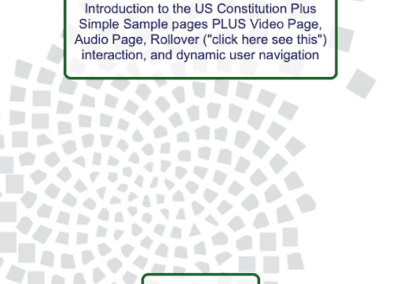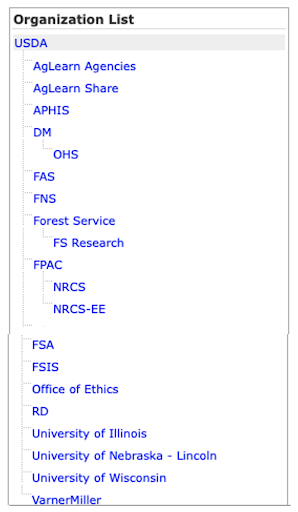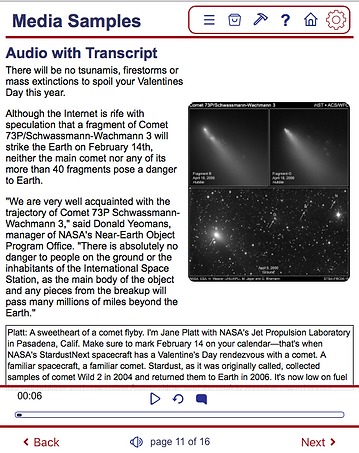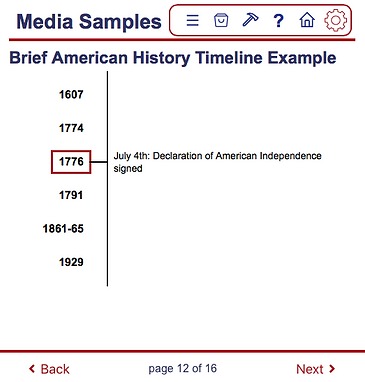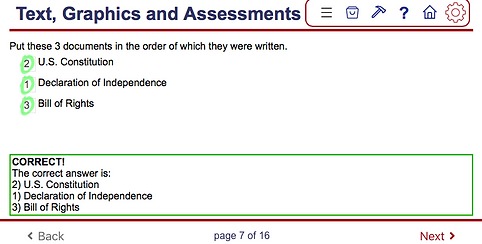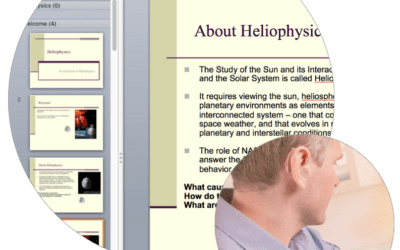Conformant eLearning at Scale: How do you scale the production of Section 508-compliant eLearning across your entire agency?
The answer is CourseAvenue Studio.
CourseAvenue is an eLearning authoring platform that generates 508 compliant learning materials – right out of the box.
This capability contrasts with every other e-learning authoring product that “retrofits” Section 508 compliance into its technology and places the burden of compliance on the users or authors.
For an example of CourseAvenue in action, get a copy of our case study titled:
To explain how CourseAvenue’s e-learning authoring platform is able to scale the production of Section 508-compliant eLearning course work, it is first essential to understand three important distinctions:
- Section 508 accessibility expertise built into the the CourseAvenue platform
- Validating CourseAvenue eLearning courseware by third-party experts
- Designed to scale from a few users to an extended enterprise
Section 508 Accessibility Expertise Built Into The CourseAvenue Platform
As described in our recent “Does Your Dog Bite?” article, most eLearning authoring tools place the burden of knowing about all things Section 508/WCAG on the author. For anyone other than seasoned programmers, the complexity of compliance means this approach is a non-starter.
After experiencing the failings of this approach, the CourseAvenue team first invested an amazing amount time, effort and energy on both the Section508.gov and with the Web Accessibility Initiative sites.
Their goal was to answer these questions:
- What does a Section 508 compliant course look like?
- What makes one course compliant and another course non-compliant?
To answer these questions, they combined software engineering, user interface design and accessibility knowledge and got to work on building a fully Section 508 compliant course. They mapped all of the standard eLearning features and functions to their respective “accessibility” counterparts. After many years, the platform was now able to produce a fully compliant course…out of the box.
What does this mean? Consider the example of “Knowledge Checks.”
A common eLearning practice is to have “knowledge checks” that let the learner “try again” if they get the question wrong.
After studying the accessibility standards, the CourseAvenue team learned that informing a learner who might be using assistive technology that they can “try again” is an integral part of Section 508 compliance.
Stated differently, if the course creator simply puts a message on the screen telling the user they can “try again” without “setting focus” to the message – the course would fail a Section 508 compliance review. Of course unless you are knowledgeable in accessibility – you would not know this.
With a goal of NOT requiring its users to be “accessibility experts” the CourseAvenue technology will add the required code IF the person creating the course simply set the “number of attempts” field on the question to something more than 1. That’s it. Just indicate that the user can “try again” via multiple attempts and the CourseAvenue accessibility technology will take care of the rest.
Below are screen images showing the layout of a question, then the properties panel were the number of attempts can be set.


Next – apply this one “number of attempts” example to each and every element that goes into an eLearning course…
This includes many elements and varying complexity. For example…
- How external hyperlinks are handled compared to internal hyperlinks
- How video controls are made accessible
- How buttons for interactivity work
- How a dynamic table of contents for the course is automatically created and made for accessibility.
The image below summarizes this situation…
On the left is a partial list of “accessibility standards” that the user of an “authoring tool” must be aware of and apply on each and every page (which is why retrofitting accessibility to existing content usually fails).
On the right are two quick sample pages built in CourseAvenue Studio where the CourseAvenue technology applies the necessary accessibility elements consistent with Section 508 and WCAG standards.

No wonder retrofitting Section 508 compliant eLearning is “technically possible but practically impossible.” The course authoring first must learn each of the accessibility elements then configure the “authoring tool” to have the correct elements applied to each and every aspect of every page of every course.
The big difference between authoring tools and CourseAvenue e-learning platform?
In the authoring tool model, per the VPATs, accessibility is achieved if “The Author can…”. Meaning “its up to the author to implement accessibility.
In CourseAvenue’s model, the person creating the course uses the product and the technology automatically applies the required accessibility constructs.
Validating CourseAvenue eLearning courseware by third-party experts
How do we build Section 508 compliant eLearning at scale?
Every eLearning course contains common elements: text, graphics, hyperlinks, un-scored knowledge checks, scores assessments, surveys, audio, video, branching and a variety of “interactions.
These are the basic building blocks of every eLearning course. So we built a course as part of our effort to answer the question: How do we build Section 508 compliant eLearning at scale?
The course we built was not a typical eLearning course. Instead, we built a “sampler course” to exercise demonstrate how these common elements, or building blocks, work together.
Knowing our customers will have their courses reviewed by outside Section 508 compliance experts, we thought it would only be fair to go first and have our (and each building block in it) reviewed and validated by an external 3rd party. By successfully validating each of the common building blocks, we knew our customers would be successful in building their courses too.
This approach also answers the big question: how do you produce thousands of elearning courses that are conformant right out of the box? Every CourseAvenue course is assembled from “pre-compliant” building blocks – each of which was validated by independent auditors and experts.
The 3rd party validated CourseAvenue Sampler Course contains the following building blocks:
- Graphics driven “home page” with options for navigating directly to either the
- Course Table of Contents,
- The “Start” page of the course
- Dynamic Action Bar for access to the
- Table of contents
- Course Glossary
- Job aids/attachments and,
- Help
- A Simple “text only” page
- A Text page with a glossary link
- A Page with Text, Graphics, and an external hyperlink.
- A scored exam with:
- A system generated “you are about to enter an exam…” page
- Six different question types all with the interaction model that:
- Disables navigation to other areas of the course until one is out of the exam.
- Provides the learner with feedback as to correct or incorrect response
- Provides an “explanation window” to provide learners with along with extended feedback about the question and correct answer. The six different question types included were
- Fill-in the blank
- True or False
- Multiple choice
- Ordered List
- Matching
- “Satisfaction Survey”
- Page with a video
- Page with text, a graphic and audio narration
- Page with a “click here – see this” interaction
- Branching where both branches have to be visited before the Next button is enabled.
- Thank you page with text and a graphic
Designed to Scale From a Few Users to an Extended Enterprise
The secret to enabling enabling large-scale development of accessible eLearning is to involve as many people in the process as possible.
The question then becomes, how does one organize all of the people who might be able to contribute to the eLearning development and/or maintenance?
CourseAvenue’s answer is to model the entire enterprise in the Studio product – from departments all the way down to individual teams.
Can your authoring tool do that? 😉
Here’s a real life example.
The University of Wisconsin’s (“UW”) Agriculture Education group builds eLearning for the USDA. In CourseAvenue, “UW” is called an “Affiliate Organization” to the USDA. Meaning, that when people on the UW team log in, they are logging into their own “organization” under the broader USDA “parent organization”.
This is important for many reasons:
| WHAT | WHAT IT MEANS |
|
From the USDA’s branding to their specific rules around Section 508 compliance, the UW team starts with all of these assets already in place. |
|
The UW team has the flexibility to manage their own team, projects, courses, etc. |
|
Since the USDA is ultimately paying to have the courses developed, why shouldn’t they have access to all of the content during the development process? |
|
By adding USDA employees to their UW “team” – USDA and UW can both view courses are they are being developed. That’s right – no need to publish to an external site and review from there. CourseAvenue Studio enables everyone to be on the “same page” – literally! |
|
Unlike “authoring tools” – in this model, UW, when complete with the contract, simply “logs off”. The USDA then has complete access to edit, maintain and re-publish and courses that were created. |
In other platforms that rely on “authors” to retrofit section 508 compliance, all of the related to building a course is all funneled to this “author” character. The “author” then finds themself attempting to be “all things”: accessibility expert, instructional designer, graphic artist, media creator, copy writer/editor, assessment creator, etc.
Conclusion
Creating Section 508-compliant eLearning at scale is practically impossible when using a traditional “author then retrofit” approach. The limitations imposed on creativity and design, along with the complexities of programming for assistive technology, are to complex to manage at scale.
CourseAvenue solves this problem.
With CourseAvenue, eLearning teams can overcome the barriers of accessibility and ensure that their eLearning content is inclusive for all learners.
If you are trying to solve the challenge of accessible eLearning at scale, we encourage you to try CourseAvenue and review our Sampler Course. Of course, don’t hesitate to contact us for help or questions.

